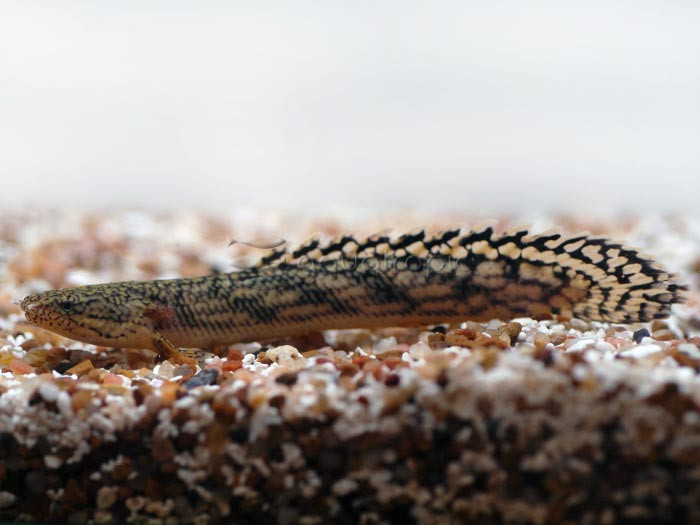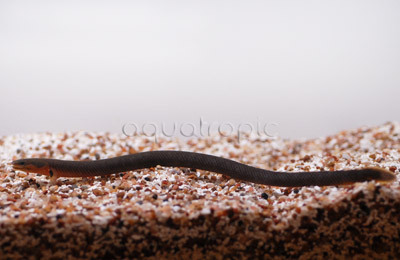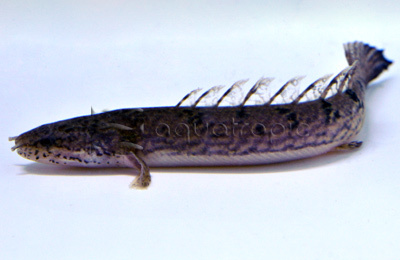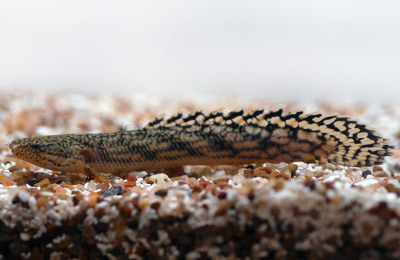Living Fossils: Bichirs and the Reedfish

More than 500 million years ago, during a period referred to informally as the Cambrian Explosion, life in the oceans exploded in diversity and complexity. This is when our own phylum, Chordata, began experimenting with the very first fish-like bodyplans. These primitive creatures, like Pikaia and Metaspriggina, had stiffened their back with a structural precursor to our own vertebrae, and this hugely important organ, called the notochord, enabled a powerful swimming motion.
Eventually, these early forms would give way to the vertebrates. The earliest examples were eel-like species that lacked jaws, and these linger on today as the hagfishes and lampreys. Other groups, like the various “ostracoderms”, had bony plates covering the head and the first paired fins, but these were all fated for extinction.
Over time, two of the anterior gill arches became modified for entirely new purposes. The first changes are thought to have improved respiration, enabling these early “fishes” to directly pump water

Reed Fish (Erpetoichthys calabaricus)
across their gills. This increase in skeletal movement was eventually honed to produce the first jaws. Thus, the first gill arch became retrofitted into the premaxilla and maxilla (the upper jawbones) and the dentary or mandible (the lower jawbone).
The oldest fossil with a complete jaw is the 419 million year old Entelognathus primordialis, which belongs to an immense group of heavily armored fishes known as the placoderms. These are thought to have first appeared earlier, during the Ordovician, but the group would come to dominate the seas of the Devonian period, diversifying into an enormous range of species. Some of them, like the fearsome predator Dunkleosteus, could reach an impressive 20 feet in length. But their success would be short-lived, as the group would soon disappear at the end of the Devonian, roughly 360 million years ago.
The Devonian is widely regarded as the “Age of Fishes”, and it’s during this period that the finned aquatic vertebrates (i.e. “fishes”) truly hit their evolutionary stride, dominating the planet’s ecosystems in a way that had previously been reserved for invertebrates. And this has continued into the present day, as the biodiversity of fishes still dwarfs that of their terrestrial descendents, the amphibians, reptiles, and mammals.
It’s during the tail end of the Devonian that the first cartilaginous sharks

Bicher Delhezi (Polypterus delhezi)
(Chondrichthyes) began to proliferate with early forms like Cladoselache (which is thought to have been preyed upon by Dunkleosteus).
The other major living group today, the bony fishes (Osteichthyes), would also appear at some point during the Devonian. The recently discovered Guiyu oneiros from 419 million years ago was recognized as one of the earliest of the lobe-finned bony fishes, whose members today include the coelacanth and lungfishes. And just last year, an even older cousin, Sparalepis, was found in China, pushing this group’s origins back into the Silurian.
Lobe-finned fishes were highly abundant and diverse in these ancient ecosystems, filling all sorts of ecological niches and coming in a wide range of sizes. But they were over time largely replaced by their close cousins, the ray-finned fishes. Of the 30,000 or so species of fish on the planet today, nearly all fall into this group, including every fish found in a freshwater aquarium (unless you’re keeping lampreys for some weird reason).
The oldest fossil from this lineage is the 420 million year old Andreolepis. It belonged to an early group of ray-finned fishes known as the palaeonisciformes. Some, like Platysomus, looked a bit like a discus and fed on plankton, while another early relative, Cheirolepis, was a streamlined carnivore.
Today, the surviving ray-finned fishes are classified into three or four main groups. The vast majority of species today are what are known as teleosts, and these are generally regarded as being more morphologically

Ornate Bichirs (Polypterus ornatipinnis)
advanced or specialized. The Gars and Bowfin form a small sister group to these, which differ in subtleties of their scales and skeleton. Then there are the Sturgeons and Paddlefishes, which have a mostly cartilaginous skeleton and a shark-like tail.
But the oldest extant group of ray-finned fishes are the bichirs and reedfish, which constitute the sole surviving members of a very distinctive lineage called Cladistia. These are thought to have diverged from their ray-finned relatives at some point during the Devonian, but the group never appears to have been particularly successful. There was never an “Age of Bichirs”.
Today, these hold onto a perilous existence in Africa, where a dozen or so species of bichirs (Polypterus) and the single ropefish (Erpetoichthys) eek out a living in the swamps of this continent. These are rugged, almost indestructible, creatures, that come encased in diagonal rows of bony, ganoid scales (the same sort can be found among the gar and its extinct relatives). Since these often live in stagnant, low-oxygen environments, they are able to gulp atmospheric oxygen, which is perhaps what has enabled them to survive so well into the present day.
Morphologically, the most unusual feature of the living cladistians is the arrangement of the dorsal fin spines, each of which is independent. So, rather than forming a single fin, they sit as individual finlets, each with a short, seemingly useless membrane behind it. However, this doesn’t apply to the aberrant fossil relatives Guildayichthys and Discoserra, which had a tall body (similar to a discus or butterflyfish). In Discoserra, the teeth were modified for plucking and grazing upon algae, showing just how far the cladistian lifestyle has shifted over the years. Those two fossils were only described in 2000, while another dozen taxa more.

Gold Dust Bluettikoferi (Polypterus palmas buettikoferi)
recognizably related to the bichirs are known (mostly from fragments, rather than whole skeletons). These weren’t described until the 1990’s, and the oldest of these is from the Cretaceous.
This meant that there was a vast period of time, more than 200 million years, from when the earliest relatives of the bichirs and reedfish is thought to have first diverged from the other ray-finned fishes and the first fossil evidence of their existence. It was only late last year that a new study focusing on the cranial morphology (the shape of particular bones in the skull) filled in this gap by recognizing an obscure group called the scanilepiforms as being the earliest known cladistians.
In a certain sense, all life on earth is old. Everything is a surviving remnant of some earlier form. But the term “living fossil” seems especially appropriate for these curious fishes. The bichir and the reedfish are like nothing else, and serve as a living reminder of the vast history of our planet and the shifting sands of piscine biodiversity.